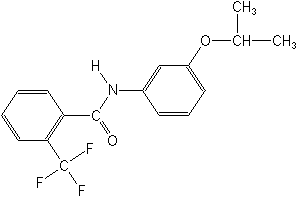-
Common NameFlutolanil
-
中文通用名氟酰胺
-
IUPACα,α,α-trifluoro-3′-isopropoxy-o-toluanilide
-
CASN-[3-(1-methylethoxy)phenyl]-2-(trifluoromethyl)benzamide
-
CAS No.66332-96-5
-
Molecular FormulaC17H16F3NO2
-
Molecular Structure
-
Category
-
ActivityFlutolanil is a systemic fungicide for use specifically against basidiomycetes. It can be applied to foliage, to soil or paddy water and as a seed treatment. Following application, it is translocated acropetally. The fungicide inhibits hyphal growth and infection cushion formation. When used on seed potatoes, it has season-long activity. Flutolanil is safe to target crops at up to 10-times the recommended use rate. The product has the lowest chemical loading of all current seed treatments and is extremely safe for both crops and operator.
Flutolanil is active against all strains of Rhizoctonia solani whereas the current standard treatment, Monceren (pencyuron) is strong on the major AG3 strain but is weak against AG3 and AG4. Repeated use of Monceren may select for an increased prevalence of strains other than AG3.
RhiNo is reported (Farmers Weekly, 2003) to provide some protection against silver scurf (Helminthosporium solani) on potatoes.
Flutolanil was one of seven fungicides tested (Crop Prot., 2003) for the control of daylily rust (Puccinia hemerocallidis), an emerging problem in the US ornamentals market.
A long term study was conducted in the US (Agronomy J., 2003) to assess effects of cultivation methods on disease control in the southeastern peanut / cotton rotation practice. Flutolanil was shown to provide good control of soil-borne disease and increased yield in peanuts, regardless of the type of cultivation (conventional-, reduced- and minimum-tillage).
Plant back intervals have been established and approved by the EPA. These are generally 12 months for other crops grown in the rotation (excluding peanuts and rice), but only 240 days for corn, soya or cotton; and 150 days for leafy vegetables and small grain cereals (IR4 workshop, 2003).
Prostar is labelled in the US for the control of various turf diseases including brown patch (Rhizoctonia solani), yellow patch (R cerealis), southern blight (Sclerotium rolfsii), red thread (Laetisaria fuciformis) and fairy ring.
Trials on soybeans in the Parana river basin area of southern Paraguay showed some control of Asian soybean rust (Phakopsora pachyrhizi) by flutolanil and many other fungicides (USDA, 2003). However, disease incidence was low. -
CropUseCropUses:
artichokes, beetroot, Brussels sprouts, bulbs, cabbages, cereals, cucumbers, aubergines, gherkins, ginger, japanese pears, konjac, leeks, lettuce, peanuts, pears, pimentos, peppers, potatoes, rice, soybeans, spinach, sugar beets, tomatoes, turf, vegetables, wheat
Potatoes
100-120 g ai/tonne seed
-
PremixAzoxystrobin+flutolanil
Dry Flowable (DF) ;Wettable powder (WP);Suspension concentrate (SC) ;Seed dressing (DS) ;Flowable concentrate for seed treatment (FS)
Premix Parters: benalaxyl; benthiavalicarb-isopropyl; copper hydroxide; copper sulfate; cymoxanil; cymoxanil fosetyl-aluminum; cymoxanil mancozeb; dimethomorph; fosetyl-aluminum; metalaxyl-M; oxadixyl; prochloraz; propiconazole; triadimenol;
-
Physical PropertiesMolecular weight:323.3; Physical form:Colourless, odourless crystals; ( tech., pale yellowish/greyish powder). Density:1.32 (20 °C); Composition:Tech. is 97.5%. Melting point:104-105 °C; Vapour pressure:6.5 × 10-3 mPa (25 °C); Partition coefficient(n-octanol and water):logP = 3.7; Solubility:In water 6.53 mg/l (20 °C). In acetone 1439, methanol 832, ethanol 374, chloroform 674, benzene 135, xylene 29 (all in g/l, 20 °C).; Stability:Stable in acidic and alkaline media ( pH 3-11). Stable to heat and sunlight.;
-
ToxicologyOral:Acute oral LD50 for rats and mice >10 000 mg/ kg. Percutaneous:Acute percutaneous LD50 for rats and mice >5000 mg/kg. Non-irritating to skin and slightly irritating to eyes (rabbits). Inhalation: LC50 for rats >5.98 mg/l. Phytotoxicity:Non-phytotoxic to cereals, rice, vegetables and fruits, when used as directed. ADI:0.014 mg/ kg b.w. daily.
-
Environmental ProfileEcotoxicology:
Bees:No effect, even with direct spray on insect.Birds:Acute oral LD50 for bobwhite quail and mallard ducks >2000 mg/ kg.Daphnia: LC50 (6 h) 50 ppm.Fish: LC50 (96 h) for bluegill sunfish 5.4, rainbow trout 5.4, striped mullet 4.65 ppm; (72 h) for carp 2.3 ppm.
Environmental fate:
Soil: DT50 190-320 d (flooded soil), 160-300 d (upland) (J. Pestic. Sci., 8, 529-535 (1983)).Plant:In peanuts, the principal metabolites include both free and conjugated flutolanil and N-(3-hydroxyphenyl)-2-(trifluoromethyl)benzamide, see S. M. Smith et al., Proc. 8th IUPAC Int. Congr. Pestic. Chem -
Transport InformationSignal Word:CAUTION; Hazard Class:III(Slightly hazardous)
Porduct NewsMore
EU told not to 'punish' farmers as 'vital' substances set to expire
Benfluralin Dimoxystrobin Fluazinam Flutolanil Mancozeb Mecoprop-P Metiram Oxamyl Pyraclostrobin
Nichino America Signs Fungicide Supply Agreement with PBI-Gordon Corporation
China approves Sipcam's 2 fungicides for rice sheath blight
Azoxystrobin Flutolanil Tebuconazole

 0
0 Subscribe
Subscribe
